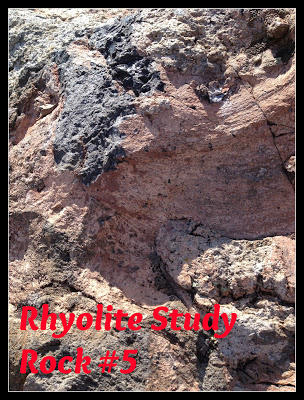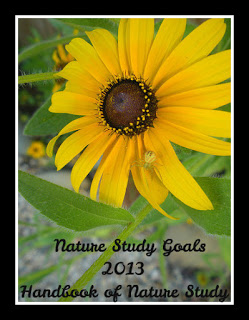During our last trip to Yosemite National Park, we made a stop on the way there at Mono Lake. There at the Visitor Center they have a display of local rocks right out in front of the building. There were three large specimens to really look at closely and two of them are on my list of rocks from my nature study goals.
As a side note: This is an awesome Visitor Center and it does a lot of things right in my opinion. There is an interesting display of natural as well as cultural items. They have a video that they play that gives you a great sense of just how special a place Mono Lake is in so many way. It is also a fantastic birding spot! If you happen to find yourself on the east side of the Sierra Nevada, don’t miss this stop at the eastern entrance to Yosemite National Park.
Rhyolite is a volcanic rock that can be pale gray, pink, or yellow. The chunk they had at the Visitor Center was reddish with gray and black.
In this area there is a large rhyolite dome that we are anxious to go back and see up close. We were unable to collect a rock here so the photos will have to make due for this time around. I did look in the gift shop for a rock to purchase but they didn’t have anything but a small collection of rocks for the Sierra Nevada….which I bought and am enjoying a lot.
Interesting facts
(which makes sense now that I have done some reading)
- The glassy rhyolites include obsidian, pitchstone, perlite, and pumice.
- Obsidian is the pure volcanic glass formed from rhyolite
- Pumice a volcanic rhyolite glass that has cooled in the form of bubbles.
We are planning on going back to this area again and exploring the differences between rhyolite, obsidian, and pumice. The specimen above is a large hunk of obsidian found at the Visitor Center.
Now that I know the relationship between these three kinds of rocks it makes it much more interesting.
For my reference—
 |
| Photo Credit for this photo: Daniel Mayer |
The photo above shows obsidian on the top and rhyolite on the bottom with a very different texture. The photo was taken at Panum Crater which is near Mono Lake.
So even though we didn’t actually collect a samples this time, we feel like we can check this rock off the list. We are continuing to work our way through the Rocks, Fossils, and Arrowheads book.



